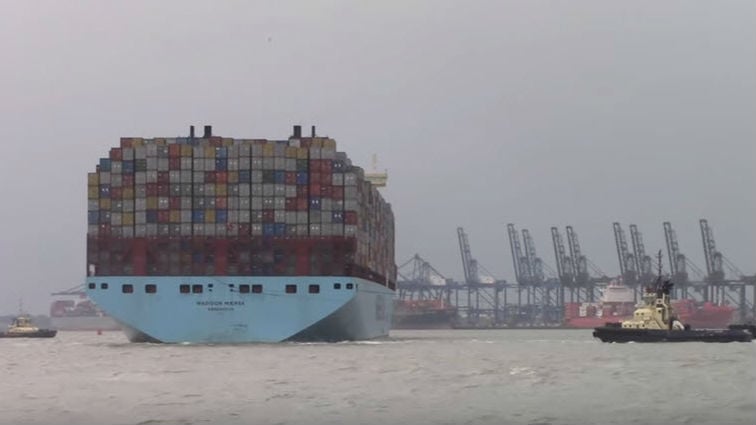Countering the Container Ship Glut

Shipping consultant Dynamar has released its latest edition of Top 25 Container Liner Operators highlighting the lack of orders for ultra-large container ships in 2016. Are there too many too big ships?
“Cost reduction, in the form of larger, less gas guzzling and more efficient ships has been the answer to low rates of the top container liner operators,” says report author Darron Wadey. “It started with Maersk Line’s 2006-launched 15,600 TEU E-class, developed and built for the Europe-Far East trade. High volumes; an excellent relationship between time spent at sea versus time in port; capable container terminals: this trade is the ideal route for ultra-large container ships to reap the maximum from their economies of scale.”
Worried by the Danish company’s lower slot costs eroding their market share, other carriers followed suit in big numbers. By mid-2016, eighteen of the top 25 lines controlled 100 percent of all ultra-large container ships operating and 94 percent of the orderbook, representing 366 ships/4.9 million TEU, and 156 vessels/2.7 million TEU, respectively. Capacities range between 10,000 TEU and 21,200 TEU. By the end of 2016, 178 ultra-large container ships with an average capacity of 15,300 TEU operated between North Europe and Asia.
.jpg)
A deluge of large newbuildings combined with a faltering market resulting in severe overcapacity inducing a bitter rate war ensuing dramatic losses: it is the price of too many too big ships, says Wadey.
“Aware of the overcapacity damage done with their financials turning deep dark red, no carrier ordered any ultra-large container ships in 2016. That is to say, almost, as in December IRISL fulfilled an earlier “promise” to go for ultra-large container ships as well, ordering an initial 14,500 TEU unit.”
Since 2005, capacity has outgrown carryings by 38 percent. Dynamar data indicates that 10 of the 12 top 25 carriers lost an average of $163 per TEU in the first nine months of 2016. Much larger ships and lacklustre growth caused North Europe-Far East frequency to fall to 16 weekly services, down from 32 ten years ago.
Billion Dollar Losses
For the first time, as a group, the 25 largest operators collectively posted a net loss in 2015, this running into hundreds of millions of dollars. For the first nine months of 2016, the combined net result of twelve reporting lines fell by more than $13 billion.
Over the same nine-month period, spot rates quoted for the 10,500 nautical miles Shanghai-Rotterdam leg were $618 all-in per TEU on average. This equals less than six dollar cents per nautical mile. Quotations ranged between $205 in March to $699 in July.
Alliance Action
In January 2015, four East-West Alliances kicked off:
• 2M - Maersk Line, MSC
• CKYHE Alliance - Coscon, Evergreen, Hanjin, “K” Line, Yang Ming
• G6 Alliance - APL, Hapag-Lloyd, Hyundai, MOL, NYK, OOCL
• Ocean Three - China Shipping, CMA CGM, UASC
Less than one-and-a-half year later, in April/May 2016, the relevant carriers announced drastic re-arrangements of their groupings. Taking effect April 2017, these will be:
• 2M+ - Maersk Line and MSC, plus Hyundai sharing space
• Ocean Alliance - CMA CGM/APL, Coscon, Evergreen, OOCL
• THE Alliance - Hapag-Lloyd/UASC, Hanjin, “K” Line, MOL, NYK, Yang Ming
Consolidations actualized or initiated in 2016 saw six of the original top 20 lines go:
• China Shipping merged into Coscon (February)
• Acquisition of APL by CMA CGM (June)
• Hanjin going under (September)
• Merger-to-be of UASC into Hapag-Lloyd (1Q 2017)
• The proposed joint venture between “K” Line, MOL and NYK (September 2017)
• Maersk Line’s intended acquisition of Hamburg Süd (late 2017)
In the course of all the above sweeping, powerful changes, smaller liner companies come under great pressure to consider consolidation as well, says Wadey.
A Happy New Year
Despite all doom and gloom, at the very end of 2016 it was reported that shipping industry confidence had hit its highest level in 15 months, he says. It may have helped that in the fourth quarter, spot rates in all long haul trades from Shanghai saw a recovery.
“Ongoing container liner consolidation as so convincingly initiated in 2016 should help addressing all challenges if the larger companies and alliances seriously work on eradicating the current excess tonnage while keeping future capacity expansion in check.
“2017 promises to become another exciting year,” says Wadey.
The opinions expressed herein are the author's and not necessarily those of The Maritime Executive.
